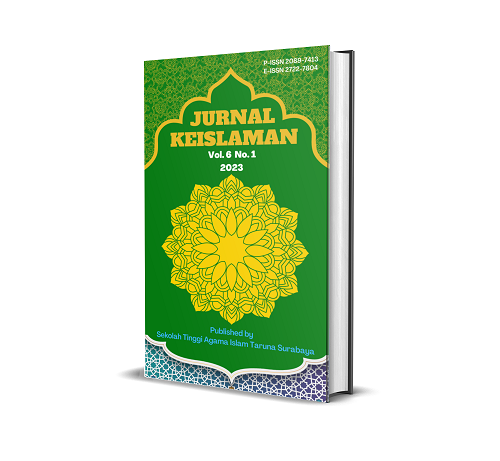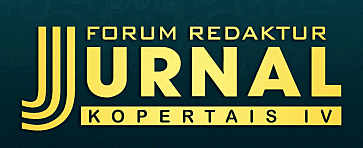Identifikasi Solusi Problematika Pelafalan dan Penulisan Huruf Hijaiyah Pada Santri Usia Dini di TPQ Al-Firdaus Sidoarjo
Abstract
The purpose of this study was to describe the problems experienced by Al-Quran educational institute students in pronouncing and writing Hijaiyah letters. To achieve the research objectives, descriptive qualitative research was used. The data collection methods used in this study were observation, documentation, and interviews. Researchers used observation to collect data, namely with an observation instrument on students aged 3-5 years at Al-Firdaus Al-Qur’an Educational Institute of Sidoarjo who have various characters in the pronunciation and writing of Hijaiyah letters. While the interviews were used to deepen the analysis of the problems of pronouncing and writing Hijaiyah letters. The results of the research are as follows: problematic ability to say Hijaiyah letters arises because students have delays in aspects of language development, lack of focus on paying attention to the teacher. As for the problems in the ability to pronounce and write Hijaiyah letters occur in students and to overcome obstacles, several methods are applied. The child's ability is observed first before determining the appropriate method and is felt to be effective. Some of the methods used are the Musyfahah or Tongue Fighting Method, the 'Ardul Qira'ah or Reading Deposit Method, and finally the Tracing MethodReferences
Aljojo, Nahla, Asmaa Munshi, Wafa Almukadi, Azida Zainol, Ihdaa Alanaya, Hawazin Albalawi, Ghadeer Alharbi, et al. “The Design and Implementation of an Arabic Pronunciation Application for Early Childhood.†Journal of Technology and Science Education 9, no. 2 (2019): 136–52.
Arikunto, Suharsimi. “Dkk. 2006.†Penelitian Tindakan Kelas, 2002, 36–40.
Iqromah, Fitri. “Identifikasi Kemampuan Anak Dalam Mengenal Huruf Hijaiyah Di TK Se-Kecamatan Samigaluh Kulon Progo.†Pendidikan Guru PAUD S-1 7, no. 1 (2018): 11–24.
Machado, Jeanne M. Early Childhood Experiences in Language Arts: Early Literacy. Cengage Learning, 2015.
Mamlu’ah, Aya, and Devy Eka Diantika. “Metode Yanbuâ€TM a Dalam Penanaman Kemampuan Membaca Huruf Hijaiyah Pada Santri TPQ At-Tauhid Tuban.†Al Ulya: Jurnal Pendidikan Islam 3, no. 2 (2018): 110–19.
Santoso, Subhan Adi, and others. “Implementasi Metode Iqra’dan Metode Tilawati Dalam Pembelajaran Al-Qur’an Di Madrasah Diniyah Al-Falah Modung Bangkalan.†Jurnal Pendidikan Islam 4, no. 1 (2018): 2–18.
Waqfin, Mohammad Saat Ibnu. “Penerapan Metode Tilawati Dalam Pembelajaran Al-Quran Dan Kemampuan Baca Al-Quran Santri Di TPQ Darussalam Kepanjen Jombang.†JoEMS (Journal of Education and Management Studies) 2, no. 6 (2019): 1–6.
Zarkani, Mohammad. “Pengenalan Pendidikan Dan Pengajaran Baca Tulis Al-Qur’an Untuk‎ Anak Usia Dini.†Al-Amin Journal: Educational and Social Studies 5, no. 1 (2020): 38–50.
Copyright (c) 2023 Husni Abdillah, Rokhmatus Solicha, Syahidah Sahda Shofariyah, Indah Machmudah, Putri Dzaqiyatus Sholihah

This work is licensed under a Creative Commons Attribution-ShareAlike 4.0 International License.
Authors who publish with this journal agree to the following terms:
- Authors retain copyright and grant the journal right of first publication with the work simultaneously licensed under a Creative Commons Attribution-ShareAlike that allows others to share the work with an acknowledgement of the work's authorship and initial publication in this journal.
- Authors are able to enter into separate, additional contractual arrangements for the non-exclusive distribution of the journal's published version of the work (e.g., post it to an institutional repository or publish it in a book), with an acknowledgement of its initial publication in this journal.
- Authors are permitted and encouraged to post their work online (e.g., in institutional repositories or on their website) prior to and during the submission process, as it can lead to productive exchanges, as well as earlier and greater citation of published work (See The Effect of Open Access).






















